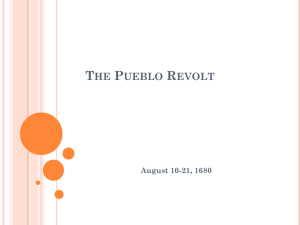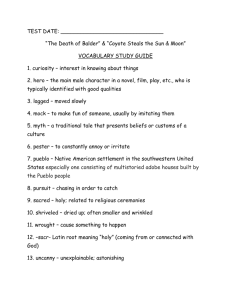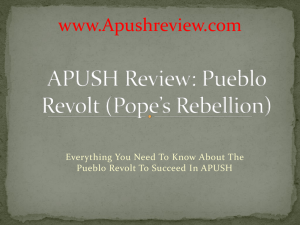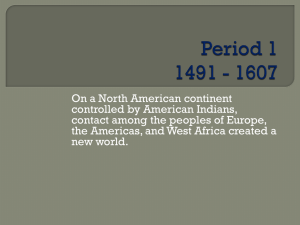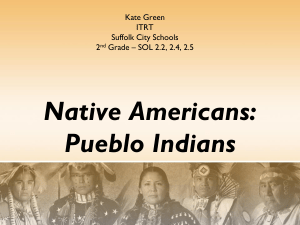Pueblo Runners and the Pueblo Revolt-1680
advertisement
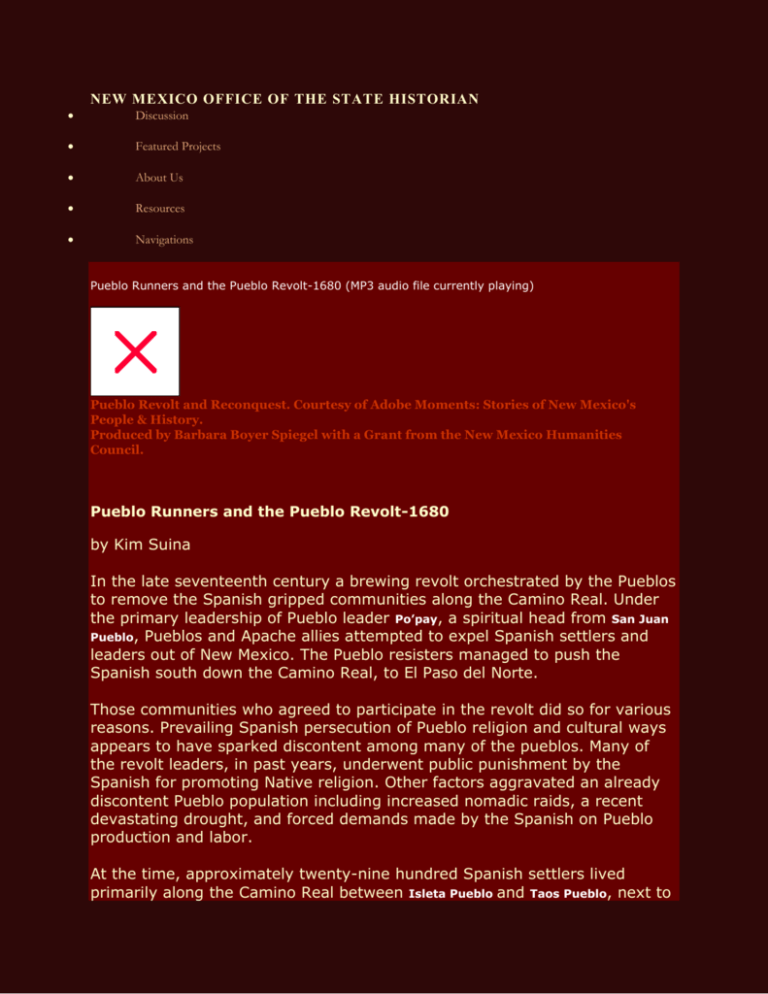
NEW MEXICO OFFICE OF THE STATE HISTORIAN Discussion Featured Projects About Us Resources Navigations Pueblo Runners and the Pueblo Revolt-1680 (MP3 audio file currently playing) Pueblo Revolt and Reconquest. Courtesy of Adobe Moments: Stories of New Mexico's People & History. Produced by Barbara Boyer Spiegel with a Grant from the New Mexico Humanities Council. Pueblo Runners and the Pueblo Revolt-1680 by Kim Suina In the late seventeenth century a brewing revolt orchestrated by the Pueblos to remove the Spanish gripped communities along the Camino Real. Under the primary leadership of Pueblo leader Po’pay, a spiritual head from San Juan Pueblo, Pueblos and Apache allies attempted to expel Spanish settlers and leaders out of New Mexico. The Pueblo resisters managed to push the Spanish south down the Camino Real, to El Paso del Norte. Those communities who agreed to participate in the revolt did so for various reasons. Prevailing Spanish persecution of Pueblo religion and cultural ways appears to have sparked discontent among many of the pueblos. Many of the revolt leaders, in past years, underwent public punishment by the Spanish for promoting Native religion. Other factors aggravated an already discontent Pueblo population including increased nomadic raids, a recent devastating drought, and forced demands made by the Spanish on Pueblo production and labor. At the time, approximately twenty-nine hundred Spanish settlers lived primarily along the Camino Real between Isleta Pueblo and Taos Pueblo, next to the lifeline of the region—the Rio Grande, and its tributaries. Thirty-three Franciscans resided among the Pueblos, proselytizing to reportedly twentyfive thousand Pueblo converts. In 1675 the Spanish publicly flogged forty-three Indians and hanged four men for practicing sorcery and plotting to overthrow the Spanish. Many of the survivors played an active role in the 1680 revolt. After himself enduring physical punishment, Po’pay fled north up the Camino Real from his home village of San Juan to Taos Pueblo. There he remained in hiding for several years, where he resolved to overtake the Spanish. Under a veil of secrecy Po’pay worked out the details for staging a rebellion. He revealed his secret plans to a few Pueblo spiritual leaders, many of who had been punished in the past by the Spanish. They moved ahead, and attempted to galvanize widespread Pueblo support. In the late spring of 1680, messengers met in Taos. Po’pay instructed them to take deerskin pictographs to each of the Pueblos, informing the people of an uprising that would occur in August on the first night of the new moon. The runners assembled again in August and Po’pay charged them with a second mission. He gave each of the runners a knotted cord made of maguey fiber, and directed them to deliver the cords to each of the Pueblo villages. The cord acted as a type of calender, with each knot signifying the number of days before the proposed outbreak of the rebellion. Revolt leaders entrusted runners to safely deliver the message or face the penalty of death if they revealed the secret plot or the significance of the cord to any inappropriate individuals. According to a summary from an interrogation conducted by the Spanish more than a year after the revolt, a Keres Indian named Pedro Naranjo from San Felipe described how Po’pays directions were carried out: He said that the cord was passed through all the pueblos of the kingdom so that the ones which agreed to it [the rebellion] might untie one knot in sign of obedience, and by the other knots they would know the days which were lacking; and this was done on pain of death to those who refused to agree to it. As a sign of agreement and notice of having concurred in the treason and the perfidy they were to send up smoke signals to that effect in each one of the pueblos singly. Some disagreement exists on how each community signaled their willingness to participate in the revolt. Some scholars believe that Pueblo leaders sent smoke signals which could be seen by organizers from far away, while other believe that upon receiving the cords village leaders untied the knots signifying their intent to execute Po’pay’s Plan. The success of the revolt hinged on each of the Pueblo villages receiving notice of the plot so that each would stand in unison on 11 August 1680, the day that Po’pay had marked to overthrow the Spanish. Revolt leaders charged runners with one of the most important tasks—to bring word to Native communities separated by hundred of miles and geographic roadblocks. The testimony of a Tesuque man named Juan, interrogated on 11 December 1681 detailed how runners carried the cord under strict orders to all the Pueblo villages, as was retold by Spanish officials: he said that he [Po’pay] took a cord of maguey fiber and tied some knots in it which indicated the number of days until the perpetuation of the treason. He sent it through all the pueblos as far as Isleta, there remaining in the whole kingdom only the nation of Piros who did not receive it; and the order that the said Pope gave when he sent the cord was under strict charge of secrecy, commanding that the war captain take it from pueblo to pueblo. It was crucial that word of the plot did not reach the Spanish or all hopes of overthrowing them would be lost. For miles they ran; runners that have been described by the Spanish as “the swiftest youth,” to communities up and down the Camino Real. Other than a short description found in Spanish documents, there is little else to tell us about the identity of these runners and how they may have been organized. However, from Indian myths and contemporary observations of the Pueblos and other Native peoples running has always played an important part of the culture and remains an important part of ritual today. Runners delivered the rope from end to end of Pueblo country, to every village except for those of the Piros, which Po’pay did not invite to join the revolt. Runners carried Po’pay’s message from the farthest northern pueblo of Taos to the southernmost village of Isleta. The messengers stopped at almost all the Pueblos in the province; at the northern communities of Taos, Picuris, San Ildefonso, Tesuque, Santa Clara, Nambe, and Pojoaque; the Tano villages of Pecos, San Cristóbal, Galisteo, and Sán Lazaro; and the mixed Tano/Keres villages of San Marcos and La Cienega. And further south, they gave word to the Keresan peoples of Santo Domingo, Cochiti, San Felipe, Santa Ana, Zia, andAcoma, and than to the people of Sandia, Jemez, Puaray, and Alameda. Runners even traveled to the distant villages of the Zunis and the Hopis, over 300 miles away. After two Tesuque runners, Nicolas Catua and Pedro Omtua, had delivered word of the revolt to the Tanos, San Marcos, and La Cienega, leaders from those villages traveled to Santa Fe and notified the Spanish of the planned rebellion. These villages initially refused to take part in the revolt for unknown reasons but later joined after fighting erupted. Once learning of Po’pay’s secret scheme, Gov. Antonio de Otermín immediately sent the maestro de campo Francisco Gómez Robledo to arrest the two runners. That same day Spanish officials in Santa Fe tortured the Tesuque men, forcing them to divulge details of the impending revolt. The Spanish had discovered the plot just two days before the proposed uprising, propelling revolt organizers to act immediately before Governor Otermín had the chance to react. All along the Camino Real, villages from Taos to Isleta covering a distance of more than fifty leagues, broke out in rebellion. As word of the arrest of the two men spread, and with some confusion occurring amongst some villages on the date of the planned outbreak, many communities reacted prematurely. The northern communities along the Camino Real, which had been a hotbed for discontent, reacted first with Tesuque springing into action on August 9. That evening the Tesuques, aware of the capture of Catua and Omtua, dispatched runners to notify the pueblos to revolt the next day. On August 10, Pueblo resisters proceeded to kill village missionaries and settlers. Villages removed from the path of the Camino Real, on the outlying edges of the province like Acoma, Zuni, and Hopi had been active in past attempts at revolt and played a significant role in the 1680 revolt, by murdering those missionaries who had been residing in their immediate vicinity at the time. Indians proceeded to steal Spanish horses, isolating the northern part of the province from the southern part, and block all roads leading to Santa Fe. Native leaders took advantage of the postponed arrival of Spanish caravans traveling from New Spain up the Camino Real—which typically arrived with a replenishment of supplies—attacking the vulnerable settlement and mission in Santa Fe. Refugees from the Santa Cruz Valley and the Cerrillos district entered Santa Fe on August 13, joining others held up in the Palace of the Governors. Natives asked the Spanish to leave and free Indian slaves, but the Spanish refused to surrender; the fight for Santa Fe resumed. Nearly 500 Indian reinforcements from villages up and down the Camino Real descended on the city, in an attempt to overtake nearly 200 armed Spanish settlers. The villages of the Camino Real, both Indian and Spanish, were left in disarray. After a relentless siege, settlers from Santa Fe managed to escape and headed south to Isleta, where they believed a contingent of Spanish settlers from the Río Abajo area remained held up. Those at Isleta had already fled down the Camino Real, believing that they would meet the annual supply caravan that traveled from Mexico on its way back to Santa Fe. Eventually those settlers who fled from Santa Fe joined the others on September 13, and continued their retreat toward El Paso del Norte. For twelve years, the Spanish stayed away. In 1692, the Spanish led by Diego de Vargas marched up the Camino Real, retaking Santa Fe on September 14. Modern Pueblos have not forgotten the feats undertaken by Po’pay and other participants in the revolt, including the runners who trekked up and down the Camino Real and beyond. In August 1980, on the tricentennial anniversary of the Pueblo Revolt, Pueblo peoples chose to commemorate the event by running. Pueblo runners from almost all of the remaining 22 Pueblos journeyed more than 375 miles on foot from Taos to Second Mesa in Arizona. Each runner carried a pouch, containing a symbolic piece of knotted rawhide tied with two knots, in remembrance of the Spanish capture of Catua and Omtua. Sources Used: Agoyo, Herman. “The Tricentennial Year in Pueblo Consciousness,” El Palacio 86, no. 4 (Winter 1980–81): 27–31. Espinosa, J. Manuel, ed. and trans. The Pueblo Indian Revolt of 1696 and the Franciscan Missions in New Mexico: Letters of the Missionaries and Related Documents. Norman: University of Oklahoma Press, 1991 Hackett, Charles Wilson, ed. and trans. Revolt of the Pueblo Indians of New Mexico and Otermin’s Attempted Reconquest, 1680–1682. 2 vols. 1942; reprint, Albuquerque: University of New Mexico Press, 1970. John, Elizabeth, Storms Brewed in Other Men’s Worlds: The Confrontation of Indians, Spanish, and French in the Southwest, 1540–1795. College Station: Texas A&M University,1975. Knaut, Andrew. The Pueblo Revolt of 1680: Conquest and Resistence in Seventeenth Century New Mexico. Norman: University of Oklahoma Press, 1995. Nabakov, Peter. Indian Running: Native American History and Tradition. Santa Fe: Ancient City Press, 1981. Return to Search Results Credits Instructions Contribute Essays Podcasts Today In History Search: © 2004-2010 New Mexico State Record Center and Archives
